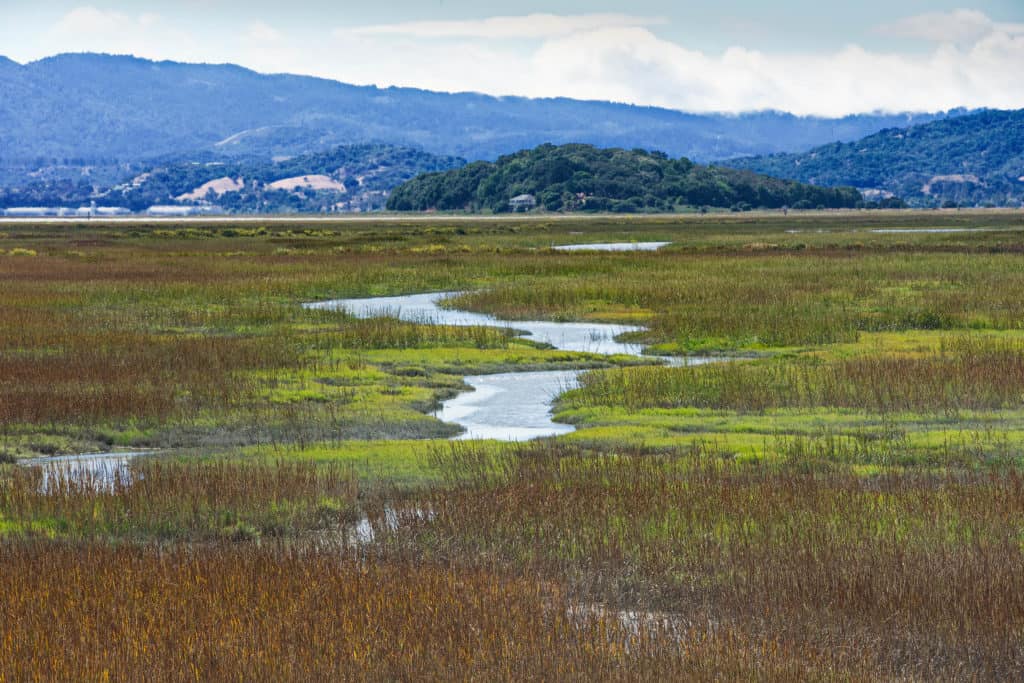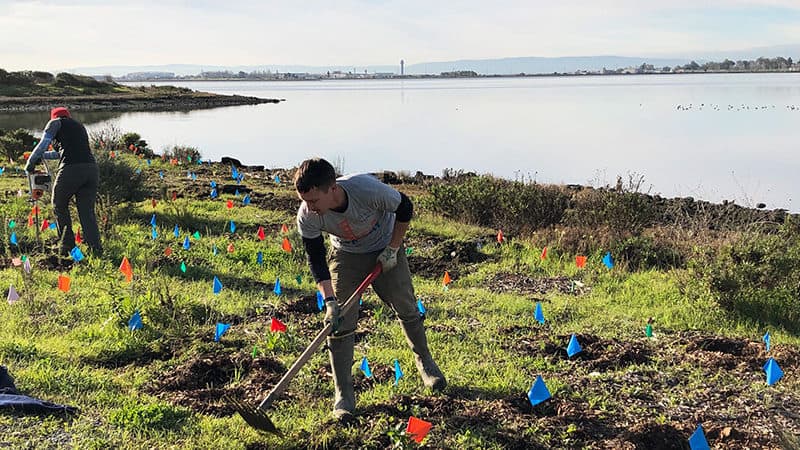One of the great things about working for Save The Bay is that we get to spend a lot of time out along the shoreline. Walking along a natural or restored marsh you notice the wide variety of native plants like pickleweed and gumplant, the enormous flocks of shorebirds that descend during the migration seasons, and the variety of recreation and relaxation opportunities that these natural areas provide. As tranquil as these settings may seem, San Francisco’s tidal marshes are actually working incredibly hard to protect the Bay.

Tidal marshes provide a host of benefits to San Francisco Bay and the surrounding Bay Area; some obvious and others subtle. Unfortunately, over the past 200 years, we’ve lost more than 90% of the Bay’s natural tidal marshes to fill, agriculture, and other development. Healthy tidal marshes filter stormwater to improve water quality in the Bay, sequester more carbon than grasslands or forests, and buffer shoreline communities from the increasingly urgent threats of sea level rise and storm surges. That’s why Save The Bay and our partners have prioritized the protection and restoration of 100,000 acres of tidal marshes around the Bay. While we’ve made great progress, we need to accelerate this work to stay ahead of the impacts of climate change.
In the coming decades, sea level rise will threaten more than 350,000 Bay Area residents who live in the areas at the highest risk for flooding, many of whom live in under-resourced and disadvantaged communities where the impact will be heightened. Rising seas will also put roads, schools, hospitals, and more than $46 billion in economic assets at risk. With these risks looming, we know we need to get as much of this work done by 2030 as possible before it becomes harder and more expensive.

Tidal marsh restoration is not as simple as just breaching a levee and letting the tides back into an area that has spent the past 100 years or more serving as a farm or industrial area. When tidal marshes are drained, the land begins to subside. Before it can begin to function as a healthy tidal marsh again, a lot of work needs to be done to acquire property, build the area back up to sea level, grade it so that the various habitats can function properly, and repopulate it with native plants (kudos to Save The Bay’s habitat restoration team who do extensive planting in the transition zone). That work requires significant amounts of funding.
In 2016 Save The Bay led the campaign to pass Measure AA which will provide $500 million over 25 years to the SF Bay Restoration Authority to fund shoreline restoration projects. Even with this historic investment by Bay Area taxpayers, the amount of funding needed for marsh restoration far exceeds what Measure AA alone can provide. That’s why we have worked with a coalition of business and environmental groups to advocate for additional restoration funding from the state and federal governments. With historic budget surpluses the past two years, the State of California is finally starting to do its part.
Thanks to the support of State Senator Nancy Skinner and Assemblymember Phil Ting who chair the Senate and Assembly Budget Committees, Senator Bob Wieckowski, Assemblymember Kevin Mullin, Senator Mike McGuire, Assembly Speaker Anthony Rendon, Senate Pro Tem Toni Atkins, and of course Governor Newsom, this year’s state budget will allocate urgently needed resources to the State Coastal Conservancy including:
- $120 million exclusively for nature-based projects to address sea level rise within San Francisco Bay
- $350 million to provide for coastal climate resilience statewide, for which projects in San Francisco Bay will qualify
With this funding, work can accelerate in areas like the South Bay Shoreline Project, which combines new flood protection for the historically disadvantaged community of Alviso in north San Jose with the restoration of 2,900 acres of tidal marsh. Former salt ponds in the South Bay can be restored to offer additional habitat for wildlife and sea level rise protection for neighbors. New areas fit for restoration can be acquired in the north Bay. And the Bay Trail can be extended to create more connections for people to experience and enjoy the shoreline in places that have long been separated from it.
The Bay’s shoreline is an incredible place, not just for the scenic beauty that it possesses but for the ways that it protects and enhances the lives of the people living in the Bay Area. California’s investment of state funding to help restore tidal marshes and other habitats is not cosmetic but is urgently needed to recenter natural systems within our communities to help mitigate and adapt to a changing climate. While this year’s state budget will make a big difference in the short term, we will look for California to maintain its commitment to funding nature-based climate solutions like tidal marsh restoration going forward.
Special thanks to our advocacy partners: Silicon Valley Leadership Group, Bay Area Council, Valley Water, TOGETHER Bay Area, and San Mateo County Supervisor Dave Pine for their support of this critically needed funding.

















































